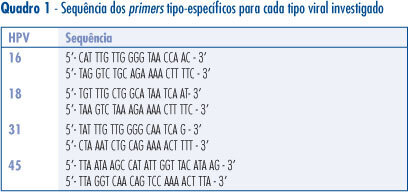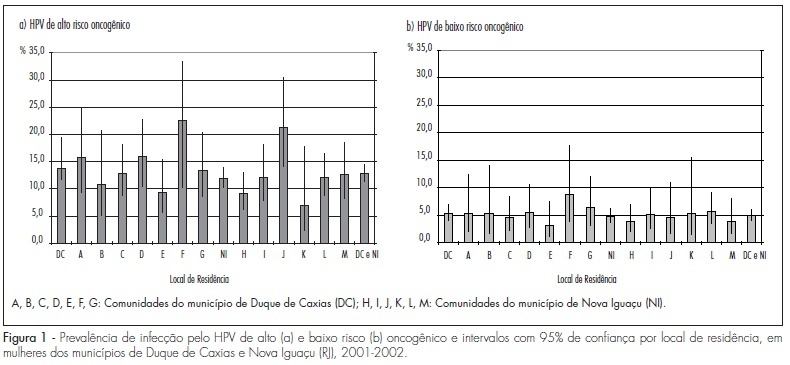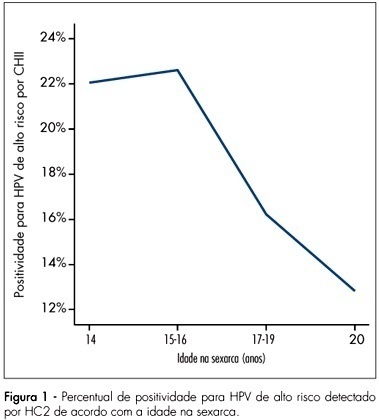Summary
Revista Brasileira de Ginecologia e Obstetrícia. 2010;32(7):315-320
DOI 10.1590/S0100-72032010000700002
PURPOSE: to determine the prevalence of HPV 16, 18, 31 and 45 in cervical screening samples of women with cellular changes and/or colposcopy suggestive of persistent high grade or low grade lesion who were submitted to conization. METHODS: a total of 120 women were included in the study. Histological analysis of the cervical cones revealed 7 cases of cervicitis, 22 of CIN1, 31 of CIN2, 54 of CIN3, and 6 invasive carcinomas. The cervical screening samples were analyzed before conization for the presence of HPV-DNA by PCR using the consensus primers PGMY09/11. HPV-DNA-positive samples were tested for the presence of HPV16, 18, 31 and 45 using type-specific primers for these HPV. RESULTS: HPV-DNA was detected in 67.5% of the studied women. HPV 16 (40%) was the most prevalent type in most ilesions, followed by HPV 31 (13.3%), 45 (13.3%), and 18 (4.1%). Multiple infections occurred in 15% of the cases and infections with other HPV types were detected in 14% of the sample. CONCLUSIONS: HPV 16 and 18 infections do not always occur as a single infection, and may be associated with other HPV types on different occasions.

Summary
Revista Brasileira de Ginecologia e Obstetrícia. 2010;32(1):39-46
DOI 10.1590/S0100-72032010000100007
PURPOSE: to evaluate the prevalence of HPV infection and associated factors among women living in the "Baixada Fluminense", state of Rio de Janeiro, Brazil. METHODS: a cross-sectional study conducted on a sample of 2,056 women aged 25-59 years covered by the Family Health Program in the municipalities of Duque de Caxias and Nova Iguaçu, state of Rio de Janeiro, southeastern Brazil. All women were submitted to the Papanicolaou and HPV detection tests in a single session by second-generation hybrid capture from December 2001 to July 2002. The prevalence of HPV was stratified by age, place of residence, schooling, smoking habit, and sexual and reproductive history. The prevalence rates associated with the studied variables were calculated by Multivariate Poisson regression. RESULTS: the prevalence of HPV was 12.3% and 5.0% for high-risk and low-risk HPV types, respectively. A reduction in high-risk HPV prevalence was observed with aging, with an increase in the 55-59 year age range. After adjusting for age, schooling, smoking, early sexual initiation and parity, high-risk HPV infection was associated with not living with a partner (1.4; 95%CI=1.1-1.8) and having more than one sexual partner (an increase of 1.4%; 95%CI=1.1-1.6, for each lifetime sexual partner). CONCLUSIONS: the prevalence of HPV was lower than that reported in other Brazilians studies, most likely because our sample was population-based. HPV infection was associated only with factors related to sexual behavior, but the potential association between HPV infection and smoking still needs to be better understood. Further studies are needed to explore these issues, as well as postmenopausal increased infection rates, and to identify the most prevalent HPV types in the Brazilian population.

Summary
Revista Brasileira de Ginecologia e Obstetrícia. 2008;30(9):437-444
DOI 10.1590/S0100-72032008000900003
PURPOSE: to verify the accuracy of uterine cervix cytology for HPV diagnosis, as compared to polymerase chain reaction (PCR) in samples of women with HIV. METHODS: 158 patients who had undergone a first collection of material from the uterine cervix with Ayre's spatula for PCR were included in the study. Then, another collection with Ayre's spatula and brush for oncotic cytology was performed. Only 109 slides were reviewed, as 49 of them had already been destructed for have being filed for over two years. RESULTS: the prevalence of HPV was 11% in the cytological exam and 69.7% in the PCR. Age varied from 20 to 61 years old, median 35 years. The HIV contagious route was heterosexual in 91.8% of the cases, and 79.1% of the patients had had from one to five sexual partners along their lives. The most frequent complaint was pelvic mass (5.1%), and 75.3% of the women had looked for the service for a routine medical appointment. The categorical variable comparison was done through contingency tables, using the χ2 test with Yates's correction to compare the ratios. The Fisher's test was used when one of the expected rates was lower than five. In the comparison of diagnostic tests, sensitivity, specificity and similarity ratios have been calculated. Among the 76 patients with HPV, detected by PCR, only 12 had the diagnosis confirmed by cytology (sensitivity=15.8%), which on the other hand did not present any false-positive results (specificity=100%). Concerning the HPV presence, the cytological prediction for positive results was 100% and 33.3% for negative, when both results were compared. Among the 12 patients with HPV positive cytology, four (33.3%) presented cervical intraepithelial neoplasia (OR=56; positive similarity ratio=positive infinity; negative similarity ratio=0.83). CONCLUSIONS: As the cytology specificity is quite high, it is possible to rely on the positive result, which means that a positive result will surely indicate the presence of HPV. The low sensitivity of cytology does not qualify it as a survey exam for HPV detection in this female group.
Summary
Revista Brasileira de Ginecologia e Obstetrícia. 2007;29(11):580-587
DOI 10.1590/S0100-72032007001100006
PURPOSE: to investigate women’s age at their first sexual intercourse and its correlation with their present age, human papillomavirus (HPV) infection and cytological abnormalities at Pap smear. METHODS: women from the general population were invited to be screened for cervical cancer and pre-malignant lesions. After answering a behavior questionnaire, they were submitted to screening with cervical cytology and high-risk HPV testing with Hybrid Capture 2 (HC2). This report is part of the Latin American Screening (LAMS) study, that comprises centers from Brazil and Argentina, and the data presented herein refer to the Brazilian women evaluated at the cities of Porto Alegre, São Paulo and Campinas. RESULTS: from 8,649 women that answered the questionnaire, 8,641 reported previous sexual activity and were included in this analysis. The mean age at the interview was 38.1±11.0 years and the mean age at the first sexual intercourse was 18.5±4.0 years. The age at the first sexual intercourse increased along with the age at the interview, i.e., younger women reported they had begun their sexual life earlier than older women (p<0.001). From the total of women who had already begun having sexual intercourse, 3,643 patients were tested for high-risk HPV infection and 17.3% of them had positive results. In all the centers, it became clear that the women with the first sexual intercourse at ages below the mean age of all the population interviewed presented higher rates of HPV infection (20.2%) than the women with the first sexual intercourse at ages above the mean (12.5%) - Odds Ratio (OR) 1.8 (IC95% 1.5-2.2;p<0,001). According to the cytology, the women with first sexual intercourse at ages under the mean, presented higher percentage of abnormal cytology > or = ASC-US (6.7%) than the women with the first sexual intercourse at ages above the mean (4.3%) - OR 1.6 (IC95% 1.3-2.;p<0.001). CONCLUSIONS: the high-risk HPV infection and cytological abnormalities identified during the asymptomatic population screening were significantly associated to the women’s age at the first sexual intercourse. Additionally, we have also identified that the women’s age at the first sexual intercourse has decreased during the last decades, suggesting an important contribution to the increase of HPV infection and the subsequent cervical lesions.

Summary
Revista Brasileira de Ginecologia e Obstetrícia. 2005;27(12):726-730
DOI 10.1590/S0100-72032005001200004
PURPOSE: to study the influence of the use of oral contraceptives (OC) on the number of Langerhans' cells in women without cervical infection by human papillomavirus (HPV). METHODS: thirty women who presented abnormal cervical cytology and colposcopy-guided biopsy with samples of uterine cervix negative for HPV were selected. The absence of HPV DNA was confirmed by hybrid capture. Langerhans' cells were identified by immunohistochemistry using anti-S100 antigens. The cells visualized in light microscopy were counted using the Cytoviewer software. The nonparametric Wilcoxon rank sum test was employed for statistical analysis. RESULTS: the average number of Langerhans' cells in OC users was 320.7/mm² and in non-users 190.7/mm², this difference being statistically nonsignificant. In the intermediary layer of the cervical epithelium a tendency towards the increase of these cells was observed, with the averages 192.1/mm² for OC users and 93.4/mm² for non-users (p=0.05). CONCLUSIONS: the present study reports a tendency towards the increase in the number of the Langerhans' cells among OC users. This result suggests the OC may induce alterations in the number of Langerhans' cells, but considering the limited number of cases, more studies should be developed for a definitive conclusion.